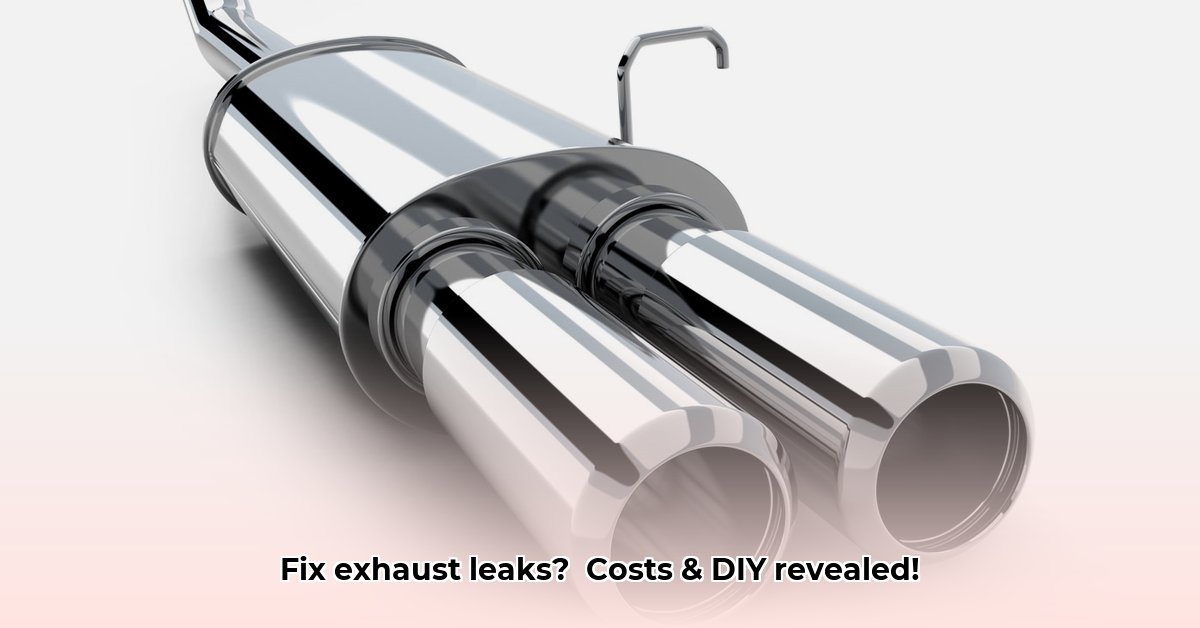That faint rumble transforming into a roar, or that unusual odor wafting into your cabin? It’s quite possibly an exhaust leak, an issue that silently impacts your vehicle’s performance and your wallet. Ignoring it is a gamble; what starts as a minor nuisance can escalate into a major problem, impacting both your car’s health and your own. This comprehensive guide breaks down the costs associated with exhaust leak repair, from simple DIY fixes to complex professional interventions. You’ll learn how to diagnose the problem, decide whether to tackle it yourself or enlist a mechanic’s expertise, locate a trustworthy repair shop, and implement preventative measures to minimize future leaks. We’ll delve into specific price ranges, such as exhaust manifold replacement, and provide actionable tips for maintaining your exhaust system’s peak condition. Let’s ensure your car runs smoothly, efficiently, and safely!
Decoding Exhaust Leak Repair Costs: A Comprehensive Breakdown
The telltale signs of an exhaust leak—that throaty rumble or the unwelcome scent of fumes—signal a problem that demands attention. Neglecting it can lead to more severe issues and a significantly larger repair bill down the line. So, how much can you expect to shell out to get it fixed? The cost of exhaust leak repair can vary significantly, ranging from a quick, budget-friendly fix to a substantial repair bill, largely depending on the nature and severity of the problem.
Understanding the Costs: What Impacts Your Repair Bill?
Several factors influence the ultimate price tag for an exhaust leak repair. Think of it like constructing a building: you have the materials (parts), the labor (mechanic’s time), and potentially preliminary expenses to identify the root cause (diagnostic fees). Identifying these elements helps you strategize against unexpected financial strain by understanding the potential factors contributing to your repair bill.
- Labor Costs: This represents the hourly rate charged by your mechanic. Typically, this can range from $65 to over $200 per hour, influenced by location and the mechanic’s level of expertise. Specialized repairs in certain locales may even exceed this range.
- Parts Costs: The expense of parts depends entirely on the components requiring replacement. A small gasket is relatively inexpensive, whereas a brand-new catalytic converter represents a significant investment. Detailed part costs are examined later in the article.
- Diagnostic Fees: Before initiating any repairs, mechanics typically need to pinpoint the exact location of the leak. This assessment often incurs a separate fee, which generally ranges from $30 to $200. Some shops may waive this fee if you proceed with the repair, so it’s always a good idea to clarify their policies upfront.
Here’s a realistic range for common exhaust leak repairs. Keep in mind these are merely estimates, which are subject to fluctuation depending on specific circumstances. A luxury vehicle, for instance, is apt to incur higher repair expenses than a standard economy car.
| Repair | Price Range | Things that can affect the price |
|---|---|---|
| Gasket Replacement | $200 – $350 | Access to the gasket, type of gasket |
| Tailpipe Repair/Replacement | $300 – $500 | Extent of damage, need for welding |
| Muffler Repair/Replacement | $350 – $850 | Muffler type, complexity of the repair |
| Exhaust Manifold Replacement | $400 – $1050 | Access issues, the type of vehicle |
| Catalytic Converter Replacement | $300 – $4000+ | Type of converter, vehicle make and model |
| Full Exhaust System Replacement | $800 – $3000+ | Vehicle type, parts quality, labor |
DIY Repair vs. Professional Help: Can You Do It Yourself?
For minor exhaust leaks—perhaps a loose clamp or a small hole suitable for patching—a do-it-yourself (DIY) repair might be feasible. But attempting more intricate repairs without sufficient experience carries inherent risks. You might inadvertently inflict further damage, which would then lead to even more extensive and costly repairs.
When to Call a Pro:
- Complex repairs: Replacing components such as a manifold or catalytic converter is generally best entrusted to professionals equipped with specialized tools and comprehensive expertise.
- Hard-to-reach leaks: Certain exhaust leaks are situated in awkward, inaccessible locations. Unless you’re a seasoned mechanic with specialized tools, reaching these areas and ensuring a proper fix can prove challenging.
- Welding needed: If your exhaust system necessitates welding, the repair unequivocally requires the attention of a skilled professional.
- Uncertainty about the problem: If you are uncertain about the underlying cause of the exhaust leak, a professional diagnosis represents a prudent investment to prevent unnecessary and potentially incorrect repairs.
Carefully weigh the advantages and disadvantages before opting for a DIY repair. A successful DIY repair can yield cost savings, but a bungled attempt could result in significantly higher expenses in the long run.
Finding a Reliable Mechanic: Getting the Best Value for Your Money
Selecting a qualified and trustworthy mechanic is paramount. Acquire estimates from multiple repair shops to gain a comprehensive understanding of fair pricing. Prioritize mechanics holding Automotive Service Excellence (ASE) certification, which signifies their completion of rigorous training and testing. Pay close attention to their transparency regarding pricing. A reputable shop will furnish a detailed breakdown of all costs, including both parts and labor.
Preventative Maintenance: Keeping Your Exhaust System Healthy
Adopting a proactive maintenance routine is critical for averting costly repairs. Regular inspections have the capacity to identify minor issues before they escalate into major problems. These inspections should encompass routine examinations of your exhaust system to detect any indications of damage, rust, or leaks. Early detection can translate into substantial cost savings and prolong the lifespan of your vehicle.
Conclusion: Don’t Ignore That Leak!
It’s never a good idea to disregard an exhaust leak. It indicates a safety hazard and is only likely to get worse, costing more money in the long run. Use this guide as a reference so you can understand your options, get multiple quotes, and choose the best approach, whether DIY or professional, depending on your problem. Remember, proactive maintenance saves you money in the long run! What steps can you take today to ensure your exhaust system stays robust and efficient?
How to Choose Between OEM and Aftermarket Exhaust Parts for Longevity
Exhaust systems are vital for your vehicle’s performance and longevity. Deciding how to choose between OEM and aftermarket exhaust parts for longevity involves assessing the system’s potential impact. A failing exhaust can lead to costly repairs. Let’s explore the options.
- OEM parts ensure a precise fit and frequently uphold factory warranties, but they tend to be pricier.
- Aftermarket parts present customization possibilities and prospective cost reductions, yet their durability and dependability can differ considerably.
- The optimal decision hinges on your budget, vehicle requirements, and the anticipated duration of ownership.
Careful investigation and selection of esteemed brands are crucial for aftermarket exhaust components.
Understanding the Costs of Exhaust Repairs
Repair costs are affected by damage and components. A gasket might cost a few hundred dollars, while a catalytic converter costs thousands. Labor fees also have a huge impact. Diagnostic testing helps pinpoint problems.
| Repair | Cost Range (USD) | Notes |
|---|---|---|
| Gasket Replacement | $100 – $500 | Varies based on location and complexity. |
| Muffler Replacement | $200 – $1000 | Dependent on muffler type and labor costs. |
| Catalytic Converter Repair | $500 – $2000+ | Most Expensive repair, often depends on vehicle make and model. |
| Exhaust Pipe Repair | $150 – $800 | Severity of damage significantly impacts the price. |
Estimates are broad. Trusted mechanics get multiple quotes.
DIY vs. Professional Exhaust Repair
DIY using readily available tools might fix a cracked exhaust pipe. Many serious problems need the expertise of a professional mechanic. DIY risks further damage, voided warranties, and injury.
Choosing a Reputable Mechanic
Find a mechanic known as ASE (Automotive Service Excellence) certified with a strong reputation. Ask for references and obtain multiple price quotes for the same repair to compare. Transparency regarding labor rates and parts used is paramount.
Preventative Maintenance for Exhaust Longevity
Regular inspections—key. Look for rust, holes, or loose connections. Turn them into major repairs. Proactive approach saves money.
OEM vs. Aftermarket: The Longevity Factor
Choosing between OEM (Original Equipment Manufacturer) and aftermarket exhaust parts impacts longevity. Consider that how to choose between OEM and aftermarket exhaust parts for longevity involves carefully assessing each. OEM parts, while expensive, are designed for your vehicle; they’re known for reliability and warranties. Aftermarket parts offer
- Gluten Free Meal Prep Ideas for Delicious, Hassle-Free Eating - November 28, 2025
- Gluten Free Meal Prep for Stress-Free and Healthy Eating - November 27, 2025
- Quick And Easy Chicken Thigh Meal Prep For Weight Loss - November 26, 2025










